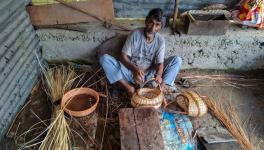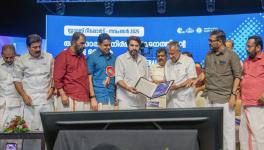Fear of Losing Identity Gives Graver Chill to Ladakhis Than Sub-Zero Temperatures
Photo by: Kamran Yousuf
Srinagar: As the unkind winter winds blow in Ladakh, one of the most isolated regions in the north of the Himalayas, the temperature has sunk to as low as -20 degrees Celsius and there are mostly sights of freeze, frost-bites and lack of fuel.
Home to about quarter a million Buddhists and Muslims, who bear the brunt of daily hardships and extreme weather at an elevation of over 11,000 feet above sea level, renewed fears of losing their culture, identity and heritage have further unsettled lives amidst the intense December chill.
The vast desert swathes of Ladakh were until recently part of the erstwhile state of Jammu and Kashmir but was sliced and declared a separate Union territory on August 5, 2019. With it, however, the region lost its prized “special status” guaranteed under Article 370 and 35 A of the Indian Constitution which secured rights over land and jobs for all locals of the undivided region.
As the decision was announced in Parliament, scores of Ladakhis, led by enthusiastic Bharatiya Janata Party (BJP) workers, gathered at the central Leh market to celebrate the move. Various civil society groups like the Ladakh Buddhist Association welcomed the decision of granting the status of Union territory, a long pending demand.
However, more than two years after Ladakh was turned into a Union territory without the right to elect a governing legislature, several social, political and religious groups called for a shutdown in the entire region, which includes the two divisions of Leh and Kargil. The shutdown on the call of two main bodies – Kargil Democratic Alliance (KDC) and an Apex Body for the People’s Movement for 6th Schedule for Ladakh – was observed on December 13 something that was seen as a culmination of simmering fear in the territory.
“The call was given by the two bodies which has become successful after the response from the people. We want the government to address the issues of the people of Ladakh,” a prominent political activist Sajjad Kargili said.
The immediate demands of the people’s representative bodies include a return of statehood for Ladakh region. They are also seeking additional seats in the Indian Parliament in both the Houses, and another demand involves the recruitment process for government jobs in the UT. One of key demands, however, is the constitutional safeguard on the lines of 6th Schedule, a constitutional provision that protects and helps preserves tribal communities.
It was these demands, that various local bodies in Leh and Kargil – separated by wide treacherous ranges spanning 200 km – in a significant development joined hands to form the umbrella apex body in September last year. In one of its first statements, the apex body said they would boycott the Ladakh Autonomous Hill Development Council, Leh (LAHDC) elections until constitutional safeguards are not extended to the UT.
Months later, on January 6, a 10-member delegation met Union Home Minister Amit Shah during which the representatives were assured of “development and conservation of the land and culture of Ladakh”. Many claim that the negotiations have not yielded anything so far.
“We met with senior politicians and government officials like MoS Home Nityanand Rai but there is no forward movement. It has been almost a year and we are still waiting but no dialogue has been initiated,” a student activist Jigmat Paljor told NewsClick.
The root of insecurities among the people of Ladakh stems from the abrogation of Article 370 and 35 A, with 95% of the tribal population believing their demands are vital to safeguard the ecologically fragile territory. Even as the insistence on shaping Ladakh as a UT was a long pending demand, the locals today feel they have been disempowered with least access to governance and decision- or policy- making about their home.
Like Jammu and Kashmir, Ladakh is administered by a Lt. Governor. The LAHDC, an autonomous council formed in mid-1990s, that administered the region with participation in decision making around healthcare, governance and economic development has since been rendered “purposeless.”
“There is no public voice in the current dispensation. Since the formation of UT there is no guarantee on protection of land, jobs and there is no representation in law-making. Only the people of Ladakh know what is best suited for this place,” KDC’s Asgar Ali Karbalai said.
Karbalai, a prominent voice and a former J&K Member of Legislative Assembly (MLA), said for the execution of developmental projects in the region only Ladakhis would know about the “preferences and priorities” and not the bureaucrats.
The fresh tension in Ladakh comes at a time when it is mired in a bitter conflict on both eastern and western borders. The region is strategically placed between the Line of Actual Control (LAC) and the Line of Control (LoC), de-facto border that demarcates it with China on the East and Pakistan on the West. Unlike Kashmir valley, the Ladakh region is located at the crossroads of key Eastern civilisations and is believed to have been associated with the historic Silk route. In earlier 20th century, it is part of the land where powers were engaged in the “great game.”
After remaining an independent entity for centuries, Ladakh was brought under the princely domain of J&K kingdom by Dogras with the help of military campaigns of Zorawar Singh in the early 1830s. More than a decade later, Dogra ruler Gulab Singh had consolidated his powers and established his order in provinces of Kashmir, Jammu, Leh, Kargil and Poonch. The borders fell silent and were mainly permeable but another deadly conflict was triggered only century later.
After the war broke out between India and China in 1962, the latter retained parts of what is known as the Aksai Chin and other areas along the Eastern and Northern Ladakh, areas used by nomadic pastoralists, a significant population, for summer grazing. Since then, encounters on the borders along the LAC have been unfriendly. The conflict did not escalate, however, and remained confined to intermittent displays of symbolic gestures of flag waving and shouting until last year the two sides clashed in bitter brawls that resulted in the death of at least 20 Indian soldiers and four Chinese armymen.
The tension along the borders has renewed fears of a possible spill-over of a wider conflict in the region where the world’s highest battlefield – the Siachen Glacier – is also located. India also fought a war with Pakistan in Kargil in 1999 leaving bitter memories with the locals.
“All of a sudden everything was changed. Ladakh is a strategic area and a sensitive area. This place cannot be administered on the mercy of three to four bureaucrats,” Karbalai said while adding that the apex body will have to launch a mass agitation in case their demands of constitutional safeguards are not met.
With a population so less, little agriculture produce and scant opportunities of employment, people of the distant Himalayan territory has for many years now emerged as a popular global tourist destination. But, visitors do not pose a threat to their culture and tradition, the locals say. There is a fear of an influx which is likely to be triggered by its new status that opens its land reserves, jobs and other resources – they were able to protect for centuries – to the outside world.
“The promises made were not kept. There was happiness earlier but it has changed into a worry now,” Jigmat said.
Caught between a rock and a hard place, for Ladakhis, the challenges are manifold to safeguard their rights, traditions and culture. So far, they have fought the weather, the big power struggles, survived on little and sailed through a troubled history but, despite that, they remain on a rocky road as new challenges have emerged since the past two years.
Get the latest reports & analysis with people's perspective on Protests, movements & deep analytical videos, discussions of the current affairs in your Telegram app. Subscribe to NewsClick's Telegram channel & get Real-Time updates on stories, as they get published on our website.
























